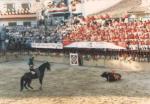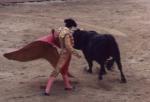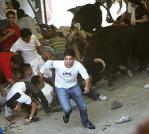

|
Bull Fighting and RunningOne of Spain's traditional sports and certainly the one most often associated with Spain, is Bull Fighting. In many parts of Europe any kind of mistreatment of animals is severely punishable by law and even experimentation is under threat. But in Spain, Bull Fighting is know as the "National Fiesta", although two peripheral regions have now banned the sport. Apart from Catalonia and the Canaries, almost every village and town and certainly every city has a bull fight at some time of year, mostly during the annual town 'fiestas', known in the south as the 'Feria' (or fair). Every evening during the fiestas at the bull ring, be it a permanent building or something set up in the main square or elsewhere, up to six bulls are fought in succession.First the bull enters the ring and various people play with it, including the main character, the matador. Then comes the picador, either on foot or on a horse, who sticks two or three stakes in the bull's neck, thus causing the head to drop. Finally, the weakened bull is played with by the matador until he considers it sufficiently weakened that he can finish it off with a sword which pierces the neck and goes, or so he hopes, right deep into the bul's body, perhaps even hitting the heart. The 'sport' -which enthusiasts regard as an art on the level of Opera, rather than a competition- is judged and rewards are given: an ear or two, a walk round the ring, etc. Should you be interested in attending one of these events, it is recommended that the first time you stay well back from the ring, enjoy the festivities and colour and don't have to look too closely at the details! In the past, bull's flesh was not particularly desirable, but these days, the fighting bulls are probably the only really well-fed 'Bio' animals, fed purely on grass and having been able to grow at a normal rate. The meat is highly prized! Apart from fighting in the ring, another spectacle can be found in many towns and villages. This is bull running. It is, of course, best known in Pamplona, which Hemmingway visited and then wrote up. Bulls are released into a street and hundreds of young people, just anyone, run in front of them as the race towards the main square, where they are again played with for a while. They are not, however, killed in the ring. They go for a more 'normal' slaughter house experience. Never is a bull released twice into a crowd or ring. This would be far too dangerous, although all bulls have been somewhat played with to test their potential in whichever arena they might end up. Most years at one or other of the village fiestas we learn of young people who have died as a result of being gored or just trampled on by one or more bulls. This is indeed a waste of a life, but is still considered a risk worth taking. Perhaps now, in our post-modern society this is even more the case. Some would consider it better to die thus than from drugs, alcohol, a traffic accident, etc.. Strange society ours!2010 may prove to be a key change year for bull fighting. On 28th July Catalonia became the second region after the Canaries to ban the fight. Prior to the vote, a petition signed by 180,000 citizens had been presented to the regional Parlament calling for the ban. The canaries banned the sport in 1991. Links:The Guardian's pages on bull fighting. For a fuller, more official and positive explanation go to the official bull fighting website (no longer with English pages). |




